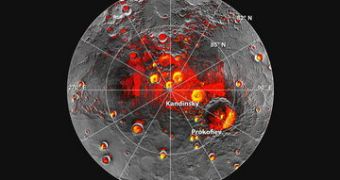NASA's Messenger spacecraft confirms long-standing suppositions: there is water ice on Mercury, the closest planet to the sun.
The frozen water is located around the north pole, a region totally hidden from the sun's action and the most susceptible to contain water on Mercury, given the extreme temperatures it otherwise registers: up to 427⁰C (800⁰F).
However, there are suppositions, so far unproved, that the planet's south pole could have ice, as well, Space reports.
The discovery's novelty and importance determined NASA to already plan for further, more complex observations in the area. A Messenger's more complex observing mission is planned for 2014 and 2015.
“There is an ongoing campaign, when the spacecraft permits, to look further northward,” declared Gregory Neumann, a NASA researcher at Goddard Space Flight Center in Maryland and main author of a study on mercury, published in the November 29 issue of Science journal.
Suppositions about the possibility of Mercury containing water are dating for over two decades. There have been two major moments when scientists got close to the truth, in 1991 and 1999, when weak signs of existing ice were detected.
However, pertinent research needed more advanced techniques. With NASA's Messenger sent to Mercury in 2011, the following events got scientists continuously closer to the truth.
A curious phenomenon noticed along the research and having raised multiple questions was that the Mercury's intense heat caused a continuous blending of the ice with the encircling loose layer.
“So what you're seeing is the fact that water ice can't survive indefinitely in these locations because the temperatures apparently spike up,” Neumann explained.
What scientists were previously missing was not the right idea, but the right place. Redirecting their attention to the poles, they found what they searched for.
Moreover, scientists revealed that there are volatile materials mixing with the ice, substances that allow organics to survive. Although organic materials alone are not enough to generate life, they are definitely marks of life.
Currently, researchers are trying to disclose whether there really are organics on Mercury and therefore, whether Mercury does allow life.

 14 DAY TRIAL //
14 DAY TRIAL //